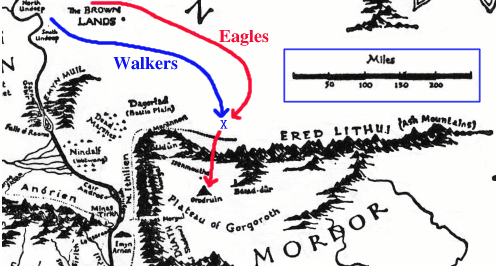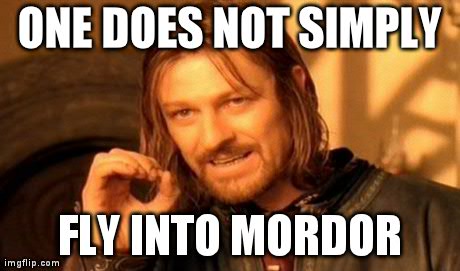People love plot holes. Not only do they give you that fantastic feeling of being smarter than highly successful people, but they can lead to hours of fun debate amongst the right people (read: real fans). One favorite in recent years has been the Eagle plot hole in The Lord of the Rings. It's outlined in this video:
This theory was discussed in more depth in a recent, over-simplified account that reads way too much into Gandalf's final words, "Fly, you fools!" That post inspired me to write this post and, hopefully, put this theory to bed once and for all.
First, let's remember the entire overarching plot device in the books: Sauron is incredibly powerful, and the only way to stop him is to destroy the ring. Sauron has agents and spies everywhere (even in Bree!) and a myriad of powers and fiends at his disposal, who do not want the ring to be destroyed. Secrecy is of utmost importance. Therefore, for the eagles to be the better plan, they must be at least as inconspicuous as the Fellowship. The reason Frodo was able to destroy the ring was because he was, in the words of Galadriel, the most unlikely person for the job.
Secondly, the would-be plot theorist should be aware that Tolkien knew the danger the eagles presented to the plot. In a letter to a producer of a possible film adaption he says, "The Eagles are a dangerous 'machine'. I have used them sparingly, and that is the absolute limit of their credibility or usefulness," (Letter 210). This alone disproves nothing, but it should keep the casual observer from thinking he has chanced upon an overlooked detail that Tolkien missed.
Alright, now to my main argument, which the perceptive reader may have already guessed: the eagles did not have better means to destroy the ring at Mount Doom than the Fellowship. The books clearly present the eagles as limited in areas which would have proven fatal to the mission. Each time the Eagles are mentioned, their vulnerabilities are also made clear.
 | |
| A smart theory posits the Eagles meeting the fellowship North of the Ered Lithui | . |
The Lord of the Eagles would not take them anywhere near where men lived. "They would shoot at us with their great bow of yew," he said, "for they would think we were after their sheep. And at other times they would be right. No! we are glad to cheat the goblins of their sport, and glad to repay our thanks to you, but we will not risk ourselves for dwarves in the southward plains." (The Hobbit, Out of the Frying Pan and Into the Fire).
Here we have the Lord of the Eagles afraid of going anywhere near where men lived because of potential harm. This isn't Mordor, this isn't Minas Tirith; heck, this isn't even Edoras. The eagles are afraid of...Lake Town. Not exactly the perfect deus ex machina.
Even when the Eagles are mustered and get involved in the Battle of the Five Armies, they are vulnerable. Sure, they help turn the tide of battle towards our heroes, but "even with the Eagles they were still outnumbered," (The Hobbit, The Return Journey). Beorn is needed to save Thorin's body.
So, even in The Hobbit, while we learn of the usefulness of the Eagles, we also learn that they have their weaknesses.
Now for the clincher, let's talk about Gandalf's escape from Isengard in Fellowship. For those who are movie-watchers only (I'm not judging...okay, a little bit), you need to know that this escape was a bit of an accident. Gandalf was not going to go to Orthanc to consult Saruman, as he seemed unwilling to help. Yet, while traveling in the East to gather information, Gandalf's fellow wizard Radagash (yep, the one with the bird nest in his hair) met him and told Gandalf that Saruman wished to meet him at Orthanc. Gandalf goes to Orthanc, but not before asking Radagash to inquire the creatures of Middle-Earth for information concerning the Ring. Luckily, Radagash was not a servant of Saruman, but only innocently (if naively) delivering a message for him. Thus, when Gandalf is in captivity, an eagle came to look for him to give Gandalf information per Radagash's request, and this allowed Gandalf to escape.
All that is to say that the Eagles' help at Orthanc was only successful through chance and luck. Gandalf, when telling the story to the Council of Elrond, makes this clear. I'll let him explain:
All that is to say that the Eagles' help at Orthanc was only successful through chance and luck. Gandalf, when telling the story to the Council of Elrond, makes this clear. I'll let him explain:
"That was the undoing of Saruman's plot. For Radagast knew no reason why he should not do as I asked; and he rode away towards Mirkwood where he had many friends of old. And the Eagles of the Mountain went far and wide, and they saw many things...And they sent a messenger to bring these tidings to me.
"So it was that when summer waned, there came a night of moon, and Gwaihir the Windlord, swiftest of the Great Eagles, came unlooked-for to Orthanc; and he found me standing on the pinnacle. Then I spoke to him and he bore me away, before Saruman was aware. I was far from Isengard, ere the wolves and orcs issued from the gate to pursue me." (The Fellowship of the Ring, The Council of Elrond, italics mine)
The key point to notice here is the implicit assertion that Saruman could have stopped such an escape if he was aware of, or had been looking for, the eagles. No doubt Saruman could have used wizardry, or perhaps many arrows to bring down the eagle. Again, this is Orthanc, not the dark strongholds of Mordor.
Also, the limited physical ability of the Eagles is clearly laid out in this passage when Gandalf asks how far the Eagle can bear him. The eagle answers, "Many leagues, but not to the ends of the earth. I was sent to bear tidings not burdens." Thus, even if the Council of Elrond (or Gandalf secretly) had decided to use the eagles, they would have had to travel in stages, not one fifteen minute flight to Mordor. After his escape, Gandalf is taken as far as Edoras, a distance of roughly 100 miles from Isengard; no small distance, and yet a rather small chunk of the 1700 miles Frodo and Sam walked to Mordor.
One more point comes from Return of the King. As the Eagles are ascending to save Frodo and Sam from the fires of Mt. Doom, Tolkien goes out of his way to say that even this task, one done after the defeat of the enemy, was not easy for the Eagles: "And so it was that Gwaihir saw them with his keen far-seeing eyes, as down the wild wind he came, and daring the great peril of the skies he circled in the air," (Return of the King, The Field of Cormallen). Here we have another something that might hinder the Eagles: poor weather. And we know that Saruman, at least, had the ability to manipulate the weather, and it can easily be assumed that Sauron had the same ability, probably to a greater extent (at the very least, we know he had control of Mt. Doom enough to send up ash clouds). Even aside from tampering, weather patterns and winds are perilous and can change rapidly, especially around an active volcano, making the eagle-flight to Mordor even more dangerous.

In conclusion, let's put all this information together. Rather than putting the Ring in the hands of the most innocent of creatures, surrounded by a group of eight capable and honorable free people and friends led by a wise Wizard, trusting on secrecy and stealth, these plot-hole theorists would put the Ring into the hands of creatures who are afraid of yew bows, and so do not even go near places where men dwell, and whose journey, despite being quicker that the Fellowship option, would also take several weeks, depending on weather patterns, and who Tolkien has clearly implied would lose a fight in which they were expected? A journey that would be done in the open sky, visible by all creatures dwelling below, including the enemy spies? Even if this journey was not discovered until the Black Gate, Sauron would have more than enough time to send a few archers with dreaded "yew bows" to Mt. Doom. Or perhaps he would just cause a ferocious storm to swallow up the eagles. Or, you know, the Nazgul! And I still haven't mentioned the corrupting power of the Ring, to which the greedy Eagles would surely be susceptible. Then think of the sheer danger for those riding on the Eagles this whole time (Bilbo himself almost falls off the Eagles in The Hobbit under peaceful conditions). Then there is the overall indifference of the Eagles towards the free peoples of MIddle-Earth. Oh, and let's consider the weight of the supplies that the Eagles would have had to place upon themselves for the journey in addition to the Fellowship members themselves. Etc., etc.
In addition, this kind of plan is the thing Sauron would expect: a plan involving might and tactical advantage, things Sauron values. The reason that the Fellowship succeeded was because Sauron could not conceive of the powerful giving the Ring to a halfling and sending him off towards Mt. Doom. Sauron could not understand this, and so he could not plan for it.
Finally, let's remember what I stated at the beginning: if the eagle plan is even a little more risky than the Fellowship-plan, it should be discarded. I hope I have clearly showed here why Gandalf and Elrond chose Frodo over Gwaihir.
Alright nerds, as you were.
Note: I'd like to give a shout-out to Sean Crist, who wrote a fantastic piece arguing that this plot hole is real. I don't agree, but I also don't want to give the impression that if you believe in the Eagle plot hole you aren't a real LOTR "fan." There is a way to argue for that opinion from an educated position.
Note: I'd like to give a shout-out to Sean Crist, who wrote a fantastic piece arguing that this plot hole is real. I don't agree, but I also don't want to give the impression that if you believe in the Eagle plot hole you aren't a real LOTR "fan." There is a way to argue for that opinion from an educated position.